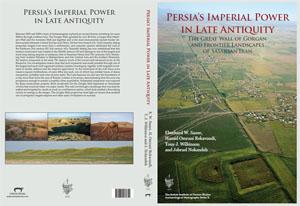New light on the Great Gorgān Wall of ancient Iran
A new book co-authored by Eberhard Sauer, Professor of Roman Archaeology, School of History, Classics and Archaeology, University of Edinburgh establishes that a Persian wall which stretches 200km through northern Iran, dates to the 5th/6th century AD, rather than much earlier, as previously thought.
The Gorgan Wall, guarded by over 30 forts, is longer than Hadrian’s Wall and the Antonine Wall put together, making it the most monumental ancient border defence system between Central Europe and China. Yet until recently, few have heard of it.
Between 2005 and 2009, in a joint project with the Iranian Cultural Heritage Handcraft and Tourism Organization (ICHHTO) and the University of Durham, funded by the Arts and Humanities Research Council, the British Institute of Persian Studies, the ICHHTO, the British Academy, the Carnegie Trust and the Iran Heritage Foundation, Professor Sauer and a team of archaeologists including Hamid Omrani Rekavandi, Tony Wilkinson and Jebrael Nokandeh, explored the remains of the wall, which is sometimes known, erroneously, as ‘Alexander's Wall.’
Now their findings have been published in the British Institute of Persian Studies Archaeological Monographs Series, under the title: 'Persia’s Imperial Power in Late Antiquity. The Great Wall of Gorgan and Frontier Landscapes of Sasanian Iran'.
Professor Sauer and his colleagues say, “Until recently, dating proposals ranged over more than a millennium, and majority opinion attributed the wall to the Parthians (3rd century BC - 3rd century AD).
“Scientific dating has now established that this massive monument was created in the 5th/6th century AD and belongs to one of the largest and most long-lasting empires of antiquity, that of Sasanian Persia (3rd-7th centuries AD).
“Stretching from modern Pakistan to Mesopotamia and into Central Asia and the Arabian Peninsula, the empire conquered in the early 7th century much of the Levant and advanced as far as the Bosporus.
“Our investigation makes clear that such expansion was made possible through one of the largest and most well organised military systems of antiquity, together with targeted investment in border defence and the empire’s agriculture.
“In the hinterland of the wall there were massive square fortifications, of some 40 ha size each, one of which has yielded traces of dense occupation, probably neat rows of army tents.
“The Late Sasanian era also saw the foundation of a city, more than twice the size of Roman London at its prime, demonstrating that the area was prosperous enough to sustain a sizeable urban population.”
The researchers say that substantial manpower was required for these construction projects.
“Brick production for the Gorgan Wall depended on thousands of kilns that received water via major canals. The wall cut through a landscape that already, a millennium earlier, was heavily settled and irrigated by canals which enabled a flourishing culture to emerge in the steppe.
“The Gorgan Wall project has shed light on what made one of antiquity’s largest empires and earlier civilisations succeed.”


